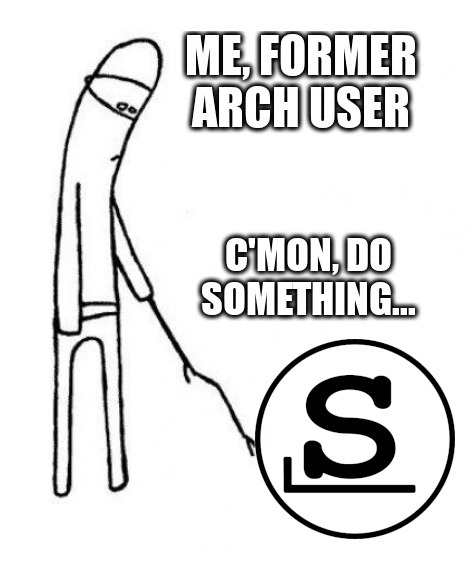this post was submitted on 09 Oct 2023
283 points (94.9% liked)
linuxmemes
21272 readers
424 users here now
Hint: :q!
Sister communities:
- LemmyMemes: Memes
- LemmyShitpost: Anything and everything goes.
- RISA: Star Trek memes and shitposts
Community rules (click to expand)
1. Follow the site-wide rules
- Instance-wide TOS: https://legal.lemmy.world/tos/
- Lemmy code of conduct: https://join-lemmy.org/docs/code_of_conduct.html
2. Be civil
- Understand the difference between a joke and an insult.
- Do not harrass or attack members of the community for any reason.
- Leave remarks of "peasantry" to the PCMR community. If you dislike an OS/service/application, attack the thing you dislike, not the individuals who use it. Some people may not have a choice.
- Bigotry will not be tolerated.
- These rules are somewhat loosened when the subject is a public figure. Still, do not attack their person or incite harrassment.
3. Post Linux-related content
- Including Unix and BSD.
- Non-Linux content is acceptable as long as it makes a reference to Linux. For example, the poorly made mockery of
sudoin Windows. - No porn. Even if you watch it on a Linux machine.
4. No recent reposts
- Everybody uses Arch btw, can't quit Vim, and wants to interject for a moment. You can stop now.
Please report posts and comments that break these rules!
founded 1 year ago
MODERATORS
you are viewing a single comment's thread
view the rest of the comments
view the rest of the comments

With Slackware, you install its entire repository (~15GB) upfront. This gives you a system with a lot of software pre-installed for a wide variety of tasks, and makes dependency resolution for the base system pointless - all dependencies are already installed.
Additional software is installed via Slackbuilds or community-maintained additional repos. Those work very similar to Arch's AUR: officially you are supposed to download, build and install packages manually using preconfigured build scripts with no dependency resolution, but tools that automate the entire process are available. And just like with the AUR, those tools aren't officially recommended, but they work and almost everyone uses them.
So while it's true that the default package manager in Slackware has no dependency resolution, that's irrelevant in practice.
One word of warning: While Slackware does work well out of the box, adjusting it to your needs is a more involved process than with other distros. Everything is done manually but it lacks the awesome documentation Arch has and includes some pitfalls due to lack of automation we're used to nowadays. For example, if you upgrade your kernel and reboot, it won't boot. Because you forgot to copy the new kernel into your EFI partition, regenerate the initramfs and point your bootloader to it. Every other distro's package manager recognizes a kernel upgrade and triggers those things automatically.
Slackware is easiest if you are a bit flexible in what you use and are fine with its default selection. If you want Gnome, best choose another distro. It's possible to build and set up, but not easily.
But once you've set everything up the way you like, it just stays that way forever and there is almost no work needed to maintain it.